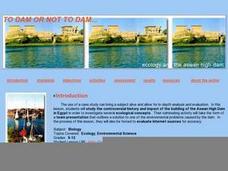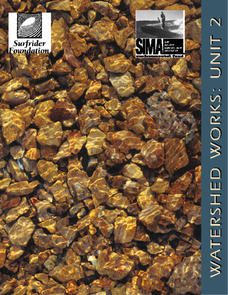Institute of Electrical and Electronics Engineers
Engineer a Dam
To begin the learning about dams, learners read (or are read to, depending on the age group) a passage about how dams work. Next, they work in groups to use the materials provided to build a small scale working dam. After the experience,...
Curated OER
Itaipu Dam and Power Plant (Brazil and Paraguay)
Learners study South America's Itaipu Dam and Power Plant in order to gain an understanding that hydroelectric power is a major means of generating electricity throughout the world. They also look into the environmental impacts that...
Curated OER
To Dam or Not to Dam
Young ecologists explore the Aswan Dam in Egypt via the internet. Each collaborative group is assigned a specific article about the ecological impact of the dam. Then they prepare a presentation to share with the rest of the class. Some...
Purdue University
Design of an Earthen Dam for a Lafayette Neighborhood
How do dams support bodies of water? Scholars engage in a hands-on STEM activity where they design, build, and test dams to learn about bodies of water and how humans use natural resources. They learn how criteria and constraints affect...
Curated OER
Building Challenges
Students work together to complete different building challenges. They use prior knowledge to build tunnels and different types of bridges. They share their creations with the group.
Curated OER
Do Dams Affect the Paddlefish Population?
Students study why dams are built and what is affected by them. They build model dams and explain how dams can be a detriment to paddlefish population.
Curated OER
Salmon vs. Dams: The Dam Removal Debate on the Elwha River
Students use roll playing to discuss the merits of tearing down these dams so that the Elwha River can run free. The activity is presented in the form of a council meeting to encourage students to try to build consensus in finding...
DocsTeach
Environmental Case Study: Hetch Hetchy Valley
What is more important: building a new school or preserving a nature reserve? Keeping a natural area clean or providing clean drinking water to a city of millions? Young scholars weigh these questions—almost literally—using an...
Curated OER
Why Do We Build Dams?
Young scholars are introduced to a dam and what a dam does. In this dam instructional activity, students explore how a dam uses water supply, electricity generation, flood control, recreation, and irrigation in order to control the water.
Curated OER
The Biggest Dam in the World
Students recognize that the Three Gorges Dam is now being constructed in China on the upper Yangtze River. They build a dam in an empty fish tankusing common materials they have at home or can easily find, such as twigs and leaves, food...
American Chemical Society
What is Wind?
Engage creative minds with an exciting activity about the power of wind. Investigators participate in class discussions while viewing images and animations of air and wind. Scholars test the relationship between wind speed and an...
Curated OER
Ecological Impact of River Dams
Students investigate their environment by completing an in-class experiment. In this ecological lesson, students define the roles of dams and how electricity is created by them. Students utilize plastic jugs, sand and tap water to...
Curated OER
The Pros and Cons of Dams
Students investigate the use of dams on rivers in order to manage water uses in particular the Flathead River and Lake. They make presentations about dam management and write a persuasive paper on the issue. If possible they visit the...
Foundation for Water & Energy Education
How Can Work Be Done with Water Power? Activity C
Third in a set of lessons regarding reservoirs, dams, and hydropower, this involves a two-day hydropower plant simulation. Collaborative groups build, maintain, and finance the plant. The transparency of the reservoir setup can be...
Curated OER
Biodiversity Debate - Stream Side Science
Role play community members who are both for and against the construction of a dam. Research the pros and cons and then hold a classroom debate. This activity ideally follows a series of stream studies, links to which are included. Use...
Curated OER
How Do Environments Change?
In this environments instructional activity, students will write in the effects fire, dams, and people can have on the environment. Students will complete 4 fill in the blank statements.
Curated OER
Water Conservation/ Pollution: Why is the Water Running?
Students consider water conservation and chemical pollution of water. For this water use lesson, students discover how water towers and dams are used to take water to desired locations. Students also discuss the effects of chemical water...
Curated OER
What Have We Done?
Young scholars investigate the effect of dams on the ecosystem. For this environmental lesson, students read case studies on the Aswan Dam and the Colorado River Basin and construct a T-chart to compare the effects on the region.
Foundation for Water & Energy Education
How Can a Dam Affect a River? Activity B
Second in a pair of activities, young ecologists continue to examine the food pyramid of a freshwater ecosystem. They take a look at the food pyramid drawn in Activity A and consider what would happen if a reservoir was created on the...
Curated OER
Watershed Works: Unit 2
The second of a three-unit lesson plan, this focuses on how human-made structures affect watersheds. Using watershed models that were built during the first unit, junior geologists now place buildings, dams, or levees into the models and...
American Chemical Society
The Periodic Table and Transuranium Elements
The periodic table has so much more to it than meets the uninformed eye. An inquiry-based lesson leads learners through the history of the discovery of several transuranium elements. They then use informational resources to build a...
American Chemical Society
The Water Cycle
Bring the water cycle into the classroom without the mess. Learners build a model of the water cycle using everyday materials. They observe the process of evaporation and condensation and relate their observations to the larger scale...
American Chemical Society
Atoms Can Be Rearranged to Make Different Molecules
Uncover the building blocks of the universe as budding chemists explore atoms and molecules in an exciting inquiry-based activity. Investigators view an interactive video describing the chemical structure of six molecules. Using...
American Chemical Society
Designing an Absorbency Test
Time to soak up some learning! A hands-on lesson teaches learners about the absorbency properties of substances. They conduct tests by dipping different materials in water to determine which hold water and then complete a handout to...
Other popular searches
- Building a Model Dam
- Dam Building Project
- Model Dam Building
- Building a Dam
- Model Dam Building Project

























